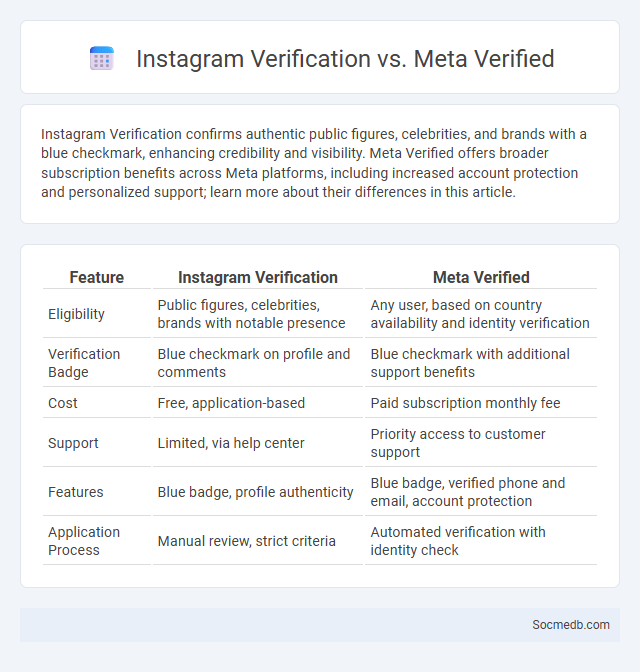
Photo illustration: Instagram Verification vs Meta Verified
Instagram Verification confirms authentic public figures, celebrities, and brands with a blue checkmark, enhancing credibility and visibility. Meta Verified offers broader subscription benefits across Meta platforms, including increased account protection and personalized support; learn more about their differences in this article.
Table of Comparison
| Feature | Instagram Verification | Meta Verified |
|---|---|---|
| Eligibility | Public figures, celebrities, brands with notable presence | Any user, based on country availability and identity verification |
| Verification Badge | Blue checkmark on profile and comments | Blue checkmark with additional support benefits |
| Cost | Free, application-based | Paid subscription monthly fee |
| Support | Limited, via help center | Priority access to customer support |
| Features | Blue badge, profile authenticity | Blue badge, verified phone and email, account protection |
| Application Process | Manual review, strict criteria | Automated verification with identity check |
Understanding Instagram Verification
Instagram verification confirms the authenticity of high-profile accounts, providing a blue checkmark that signifies trust and credibility. This verification helps your audience distinguish your official profile from impersonators, boosting engagement and brand reputation. To apply, you must meet Instagram's eligibility criteria, including account completeness, uniqueness, and notability.
What is Meta Verified?
Meta Verified is a subscription service offered by Meta Platforms that provides users with a verified badge to confirm their authentic identity across Facebook and Instagram. The program includes enhanced account protection, increased visibility, and dedicated customer support for subscribers. By verifying personal accounts, Meta aims to build trust and reduce impersonation on its social media platforms.
General Social Media Verification Defined
Social media verification is the process by which platforms authenticate the identity of users, typically highlighting authentic accounts with a verified badge to distinguish them from impersonators or fake profiles. This verification enhances your online credibility and trustworthiness, particularly for public figures, brands, and organizations seeking to protect their reputation. Verified accounts often gain improved visibility and access to additional platform features, reinforcing the importance of securing verification for a genuine social media presence.
Key Differences Between Instagram Verification and Meta Verified
Instagram Verification is a blue checkmark indicating authentic public figures, celebrities, and brands, emphasizing credibility and authenticity on the platform. Meta Verified is a subscription service offering users a verified badge along with enhanced account protection, increased visibility, and direct customer support across Meta's platforms. The core difference lies in Instagram Verification being selective and free based on notability criteria, while Meta Verified is a paid feature designed to boost user trust and platform safety.
Eligibility Criteria for Instagram Verification
Instagram verification requires your account to be authentic, unique, complete, and notable, representing a real person, registered business, or entity. Your profile must have a bio, profile photo, and at least one post, with your account being public and active to meet completeness criteria. To increase your chances, ensure your account is well-known and frequently searched for, as Instagram verifies notable accounts to prevent impersonation.
Requirements for Meta Verified
Meta Verified requires users to have an authentic profile with a profile photo and bio, demonstrate activity on the platform, and provide government-issued ID for identity verification. Your account must comply with Meta's Community Standards and be free of recent violations to qualify for verification. Meeting these criteria helps enhance credibility and trust on Facebook and Instagram.
Application Process: Instagram vs Meta Verified
Instagram's application process for Meta Verified requires submitting a government-issued ID and a verified phone number, ensuring enhanced account security and authenticity. The verification typically takes a few days, and users must meet specific eligibility criteria, including account activity and follower count. Your successful verification grants access to exclusive features and priority support, distinguishing your profile within the Instagram community.
Benefits and Limitations of Each Verification Type
Social media platforms offer multiple verification types such as blue checkmarks, email verification, and phone verification, each enhancing account authenticity and trustworthiness. Blue checkmarks provide a high level of credibility particularly for public figures and brands, while email and phone verifications offer basic security and account recovery benefits. You should choose the verification method that aligns with your security needs and the level of public recognition you require, understanding that some methods may have limitations in preventing impersonation or ensuring privacy.
Impact on Brand Credibility and Security
Social media plays a crucial role in shaping brand credibility by enabling transparent communication and fostering trust with your audience through genuine interactions and consistent messaging. However, increased exposure on these platforms also heightens security risks such as data breaches, cyberattacks, and misinformation, which can damage your brand's reputation. Implementing robust security measures and monitoring tools is essential to protect your brand's integrity while leveraging social media's reach.
Choosing the Right Verification for Your Needs
Choosing the right social media verification depends on your platform's goals and audience size. For influencers, blue checkmarks on platforms like Instagram and Twitter enhance credibility and trustworthiness. You can boost your online presence and secure your account by selecting the verification type that aligns with your specific needs and content strategy.
 socmedb.com
socmedb.com